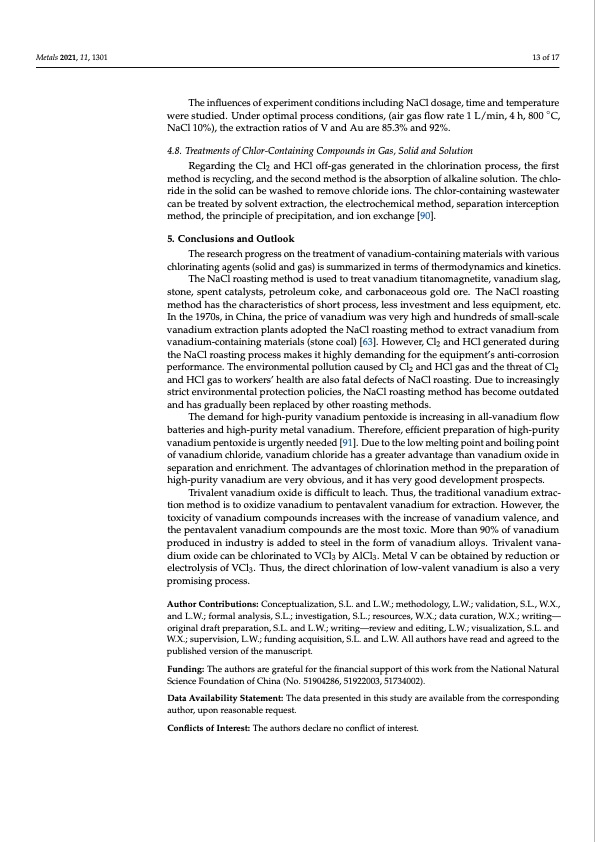
PDF Publication Title:
Text from PDF Page: 013
Metals 2021, 11, 1301 13 of 17 The influences of experiment conditions including NaCl dosage, time and temperature were studied. Under optimal process conditions, (air gas flow rate 1 L/min, 4 h, 800 ◦C, NaCl 10%), the extraction ratios of V and Au are 85.3% and 92%. 4.8. Treatments of Chlor-Containing Compounds in Gas, Solid and Solution Regarding the Cl2 and HCl off-gas generated in the chlorination process, the first method is recycling, and the second method is the absorption of alkaline solution. The chlo- ride in the solid can be washed to remove chloride ions. The chlor-containing wastewater can be treated by solvent extraction, the electrochemical method, separation interception method, the principle of precipitation, and ion exchange [90]. 5. Conclusions and Outlook The research progress on the treatment of vanadium-containing materials with various chlorinating agents (solid and gas) is summarized in terms of thermodynamics and kinetics. The NaCl roasting method is used to treat vanadium titanomagnetite, vanadium slag, stone, spent catalysts, petroleum coke, and carbonaceous gold ore. The NaCl roasting method has the characteristics of short process, less investment and less equipment, etc. In the 1970s, in China, the price of vanadium was very high and hundreds of small-scale vanadium extraction plants adopted the NaCl roasting method to extract vanadium from vanadium-containing materials (stone coal) [63]. However, Cl2 and HCl generated during the NaCl roasting process makes it highly demanding for the equipment’s anti-corrosion performance. The environmental pollution caused by Cl2 and HCl gas and the threat of Cl2 and HCl gas to workers’ health are also fatal defects of NaCl roasting. Due to increasingly strict environmental protection policies, the NaCl roasting method has become outdated and has gradually been replaced by other roasting methods. The demand for high-purity vanadium pentoxide is increasing in all-vanadium flow batteries and high-purity metal vanadium. Therefore, efficient preparation of high-purity vanadium pentoxide is urgently needed [91]. Due to the low melting point and boiling point of vanadium chloride, vanadium chloride has a greater advantage than vanadium oxide in separation and enrichment. The advantages of chlorination method in the preparation of high-purity vanadium are very obvious, and it has very good development prospects. Trivalent vanadium oxide is difficult to leach. Thus, the traditional vanadium extrac- tion method is to oxidize vanadium to pentavalent vanadium for extraction. However, the toxicity of vanadium compounds increases with the increase of vanadium valence, and the pentavalent vanadium compounds are the most toxic. More than 90% of vanadium produced in industry is added to steel in the form of vanadium alloys. Trivalent vana- dium oxide can be chlorinated to VCl3 by AlCl3. Metal V can be obtained by reduction or electrolysis of VCl3. Thus, the direct chlorination of low-valent vanadium is also a very promising process. Author Contributions: Conceptualization, S.L. and L.W.; methodology, L.W.; validation, S.L., W.X., and L.W.; formal analysis, S.L.; investigation, S.L.; resources, W.X.; data curation, W.X.; writing— original draft preparation, S.L. and L.W.; writing—review and editing, L.W.; visualization, S.L. and W.X.; supervision, L.W.; funding acquisition, S.L. and L.W. All authors have read and agreed to the published version of the manuscript. Funding: The authors are grateful for the financial support of this work from the National Natural Science Foundation of China (No. 51904286, 51922003, 51734002). Data Availability Statement: The data presented in this study are available from the corresponding author, upon reasonable request. Conflicts of Interest: The authors declare no conflict of interest.PDF Image | Extraction of the Rare Element Vanadium

PDF Search Title:
Extraction of the Rare Element VanadiumOriginal File Name Searched:
metals-11-01301.pdfDIY PDF Search: Google It | Yahoo | Bing
Product and Development Focus for Salgenx
Redox Flow Battery Technology: With the advent of the new USA tax credits for producing and selling batteries ($35/kW) we are focussing on a simple flow battery using shipping containers as the modular electrolyte storage units with tax credits up to $140,000 per system. Our main focus is on the salt battery. This battery can be used for both thermal and electrical storage applications. We call it the Cogeneration Battery or Cogen Battery. One project is converting salt (brine) based water conditioners to simultaneously produce power. In addition, there are many opportunities to extract Lithium from brine (salt lakes, groundwater, and producer water).Salt water or brine are huge sources for lithium. Most of the worlds lithium is acquired from a brine source. It's even in seawater in a low concentration. Brine is also a byproduct of huge powerplants, which can now use that as an electrolyte and a huge flow battery (which allows storage at the source).We welcome any business and equipment inquiries, as well as licensing our flow battery manufacturing.| CONTACT TEL: 608-238-6001 Email: greg@salgenx.com | RSS | AMP |